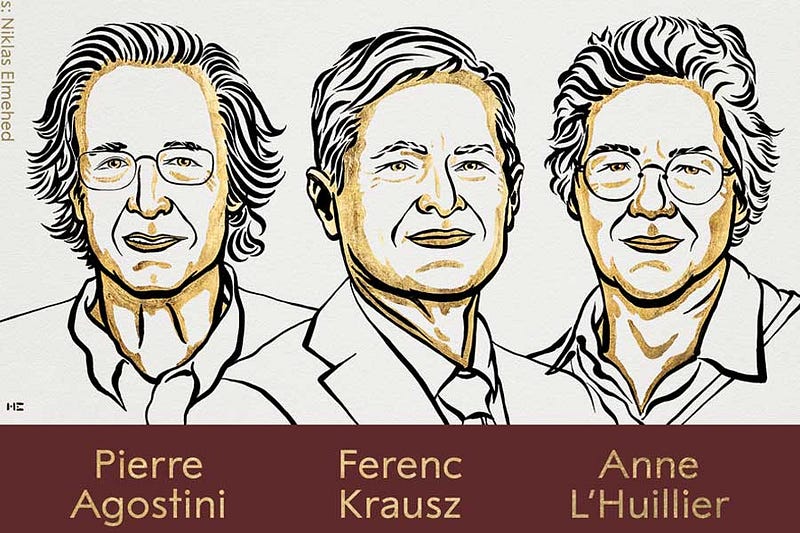Revolutionary Advances in Attosecond Physics: 2023 Nobel Prize
Written on
Chapter 1: Introduction to Attosecond Physics
This year, the Nobel Prize in Physics has been bestowed upon three eminent physicists: Pierre Agostini from Ohio State University in the U.S., Ferenc Krausz from the Max Planck Institute for Quantum Optics in Garching, Germany, and Anne L’Huillier from Lund University in Sweden. Their innovative research has propelled the field of attosecond physics, which investigates extremely brief time intervals measured in attoseconds.

Image Credit: X (Twitter) ( @ NobelPrize)
What is an attosecond? An attosecond is an extraordinarily small unit of time, defined as one quintillionth (10^(-18)) of a second. To contextualize this, an attosecond is about a billion times shorter than the duration of a blink. The laureates' work has significantly enhanced our capacity to produce attosecond light pulses.
Connect with me on YouTube, Instagram, and TikTok for additional insights. More discoveries are coming soon!
Section 1.1: The Importance of Attosecond Physics
Why is this groundbreaking? Attosecond physics unveils new pathways for scientists to investigate the tiniest particles and phenomena that occur in fractions of a second. This pioneering research involves the development of ultrafast laser pulses, which act as tools to probe the fundamental components of our universe.
These ultrafast laser pulses have diverse applications across multiple scientific fields, including chemistry, biology, and physics. They enable researchers to observe and comprehend atomic and molecular behaviors on an unprecedented timescale. This capability is crucial for deciphering the fundamental processes and interactions at atomic and molecular levels.
Section 1.2: Nobel Prize Announcement
The Royal Swedish Academy of Sciences, located in Stockholm, Sweden, announced this year’s Nobel Prize in Physics. The laureates will collectively receive a prize of 11 million Swedish kronor, approximately equivalent to 1 million U.S. dollars.
A particularly noteworthy aspect of this year's award is the recognition of Anne L’Huillier, marking her as only the fifth woman to receive the Nobel Prize in Physics. In a discipline historically dominated by men, her achievement represents a significant milestone, highlighting the gradual shift towards increased diversity in scientific accolades.
Chapter 2: Future Prospects in Attosecond Physics
The advancements in attosecond physics provide us with the ability to explore a previously unseen world on an incredibly minuscule timescale. Thanks to the efforts of these Nobel laureates, our understanding of electrons and the intricacies of subatomic processes is on the verge of a revolutionary change. The scientific community eagerly anticipates the groundbreaking discoveries and innovations that will arise from this thrilling area of research.
The first video, Attosecond Lasers (2023 Nobel Prize in Physics) - Sixty Symbols, offers an in-depth look at the significance of attosecond lasers and their transformative impact on physics.
The second video, Nobel Prize in Physics 2023: What is an attosecond?, explains the concept of attoseconds and their importance in modern science.
I’m dedicated to making science feel less like a never-ending algebra class and more like an exciting treasure hunt for knowledge!
Do you have any questions or insights? I’d love to hear your thoughts. If you enjoy articles like this, please show your support by clapping, sharing, and leaving comments. Stay tuned for more fascinating science content!
Get notified whenever Science Stories publishes new content.
By signing up, you will create a Medium account to receive updates.